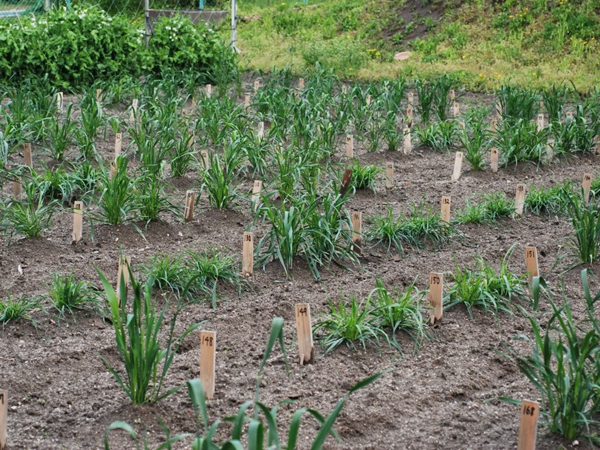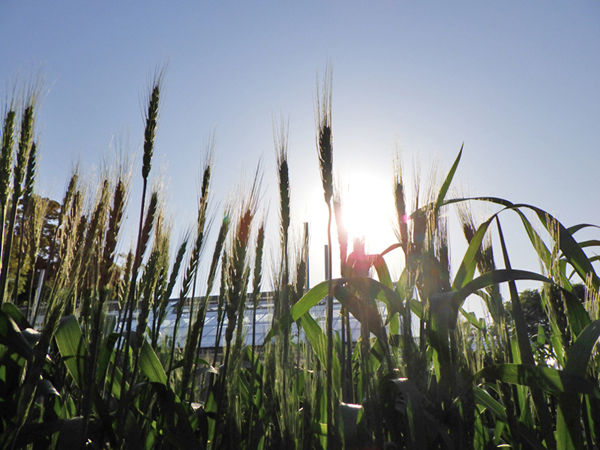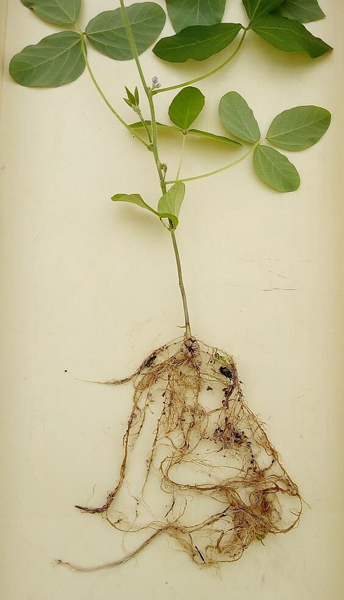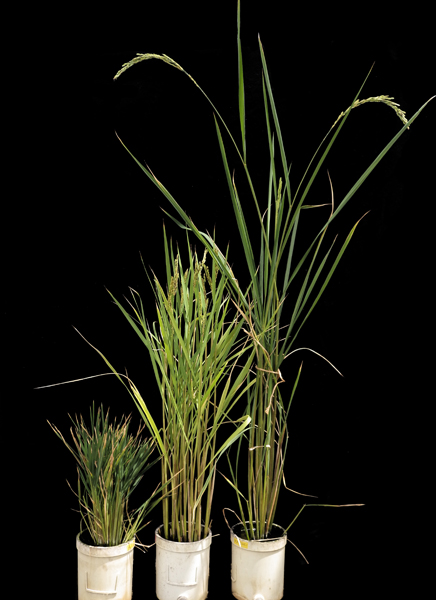研究概要/Research
遺伝資源とゲノム情報を利用してコムギの育種を加速する
Accelerating wheat breeding using genetic resources and genomic information
ゲノム配列は現代の生物学の一番大切なインフラストラクチャーとも言えます。私たちは、国際コンソーシアムに参画してパンコムギ(Triticum aestivum)の標準品種Chinese Springのゲノム配列を世界で初めて決定しました。引き続いて、多品種のゲノム配列を決定する国際プロジェクトに参画して比較ゲノム解析の基盤を築いています。他の作物やモデル植物と遜色なく、コムギを材料として育種学研究や分子生物学研究を展開できる時代が到来しました。長いコムギの研究史を反映して、おもしろい生命現象に関するたくさんの知見が集積しています。今こそ、コムギを材料として研究を始めるべき時です!
近代育種以前には世界各地にそれぞれの土地に適応して栽培されていた在来系統がありました。起源地から東に伝播した在来コムギ系統はあまり現代の育種に使われていません。私たちは、ゲノム情報を利用して世界の在来系統の多様性を評価し、東アジアに伝播したコムギ系統の遺伝的多様性を生かした系統群を作出しています。重要な農業形質に関する遺伝解析を行い、これからの世界のコムギ育種に貢献する研究を展開していきます。
Genome sequence is the most important infrastructure for modern biological researches. We have laid the foundation for comparative genomic analyses in this crop through genomic sequencing of common wheat (Triticum aestivum) cultivars. We will be able to carry out various breeding and molecular biological researches on wheat, just like any other crops or model plants. Reflecting a 100-years history of modern wheat research, a pile of knowledge about interesting biological phenomena such as polyploid evolution and genome dynamics is accumulated in wheat. Why don’t you start wheat research now?
Prior to modern breeding, there were landraces cultivated in small region around the world. Wheat lines that have dispersed eastward from their origin are not extensively used for modern breeding. We wish to contribute to world wheat breeding through evaluation of the genetic diversity of the world's landraces, and generation of a set of experimental strains that enables genetic analysis of important agronomic traits of East Asian wheat.

育種を加速化できる要素を探し求める
A quest for the factors that enhance efficient breeding process
育種は植物の計画的な遺伝的改良です。育種では、ヒトが自然の代わりに選択圧を生物にかけます。選択圧は生物の表現型(phenotype)にかかります。一般に表現型の変動は遺伝子型(genotype)と環境要因(environment)、そしてそれらの交互作用で説明されます。作物としての理想の表現型の実現に向けて、育種学では主に植物の遺伝子型を操作します。
私たちは、育種の効率化のため、次の課題に取り組んでいます。(1)イネ科植物の染色体の大部分において抑制されている遺伝的組換え頻度の人為的コントロールを目指しています。(2)外来種由来でコムギの染色体に構造異常を起こす遺伝子の機能を探る研究を行っています。(3)遺伝子型の寄与を正しく評価するため、国内外のグループと共同して表現型を正確に把握するための系統と技術の開発を進めています。
Plant breeding is the planned genetic improvement of plants. In breeding, human beings have applied selective pressure to living organisms instead of nature. Selection pressure is on the phenotype of the organism. Phenotypic variation is generally understood by sum of variations given by genotype, environmental factors and their interactions. Plant breeding mainly manipulates genotypes of organisms to achieve the ideal phenotype as a crop.
We are tackling the following issues to improve the efficiency of breeding. (1) We are conducting research on the mechanism of recombination with the aim of artificially controlling the recombination frequency. (2) We are addressing molecular function of the genes that causes a structural rearrangement of the chromosomes in wheat. (3) To evaluate the contribution of genotype to phenotype correctly, we are collaborating with other research groups to develop methodology to accurately describe the phenotype using modern technologies.

ダイズは好みの根粒菌種がいるらしい
Soybeans are choosy about nodule bacteria
植物は、根圏にすむ微生物と共生し、互いに有益な関係を形成しています。例えば、ダイズは根からイソフラボンを分泌することによって根粒菌を呼び寄せ、根粒 を形成させます。根粒は、窒素固定を行い、ダイズは固定された窒素を自らの成長に活用します。ダイズと根粒菌の良好な共生関係は、肥料の投与を減らし、結果と して地球への負荷を軽減します。2015年に国連で採択された持続可能な開発(SDGs)が唱える「ハイインプット・ハイアウトプット型の農業からの脱却」へ の足掛かりになるかもしれません。
当育種学分野では、ダイズ品種によって着生する根粒菌種の比率が異なるを端緒として、ダイズー根粒菌間の親和性に関わるダイズ側の遺伝因子を探しています。 ダイズの交雑系統を供試して系統ごとに着生する根粒菌種の比率を調査し、QTL(量的形質遺伝子座)の解析を行いました。京都府内の3か所の土壌を用いました が、効果の大きいQTLが同じ染色体領域に検出されました。根粒菌の着生を抑制する遺伝子は既に報告されていましたが、それらとは異なる新たな遺伝因子があるようです。まだ、ダイズ2品種でみられる多様性と限られた地域の土壌でしか、この現象を調査していません。現在は、ダイズ品種と根粒菌種の共生関係について、さらなる多様性を、品種と土壌を変えて調査しています。
Soybean (Glycine max) is one of the most important crops in the world. The use of legumes in biofuel production will further increase the economic impact of soybean. Enhancing the efficiency of biological nitrogen fixation by improving legume-rhizobium symbiotic relationships is one of the most efficient ways, as it has a lower cost and smaller environmental impact, to increase the productivity of legumes, including soybean and to continue sustainable agriculture. Soybean plants establish symbiotic relationships with soil rhizobia to fix atmospheric nitrogen. Understanding this genetic interrelationship is important for developing strategies to improve the agronomic potential of root nodule symbiosis in agriculture. QTL analysis of soybean recombinant inbred lines (RILs) in three different field soils and identified the indigenous rhizobia nodulating each line identified one QTL region with a highly significant additive effect.

作物の成長を制御するメカニズムの解明
Reveal the regulation mechanism of crop development
私達が普段スーパーで目にする野菜や果物はほぼ全て栽培種と呼ばれる改良種で、品種改良によって見た目や味、収量など様々な形質が改良されています。例えば、野生イネは自ら種まきをする脱粒性という性質をもっていますが、収穫前に種が落ちては困るので栽培種では脱粒性は失われています。また、草丈や葉の角度、分蘖数を改良することでイネの収量は飛躍的に高められてきました。このような作物の器官形成を制御する遺伝的メカニズムはまだまだ未解明なことが多いので、突然変異やゲノム編集などのツールを使って作物の形態形成に関わる遺伝子の機能解明に取り組んでいます。
また、動物が子供から大人へと成長するように、植物も子供(Juvenile phase)から大人(Adult phase)へと成長し、これに伴い様々な形態的・生理的変化が生じます。このような成長を制御するキーファクターとしてmiR156とmiR172という2つのmicro RNAが知られていますが、近年私たちはイネの新たな制御因子を発見しました。これらの因子を解明することで、作物のJuvenile phaseやAdult phaseについての理解を深めたいと考えています。
Almost all of vegetables and fruits in the grocery stores are improved varieties called “cultivated varieties”, which possess better appearance, taste, and yield than wild races. For example, wild rice will sow its seeds after ripening by shattering, but this character is already lost in the cultivated varieties for it decreases the yield. In addition, rice yield has been highly increased by the modification of plant height, leaf angle, and number of tillers. The genetic mechanisms that control these crop developments are not fully understood, thus we are trying to reveal the function of genes involved in crop development by utilizing induced mutation and/or genome edition.
Just like animal grows from baby to adult, plant developmental phase also transits from juvenile to adult phase, accompanied by a variety of morphological and physiological alteration. It is well known that two microRNAs, miR156 and miR172, play pivotal roles in this phase transition, and we newly found novel regulators of phase transition in rice. We hope to deepen the understanding of juvenile and adult phase in crops by analyzing these regulators.

© 2024 Laboratory of Plant Breeding.




